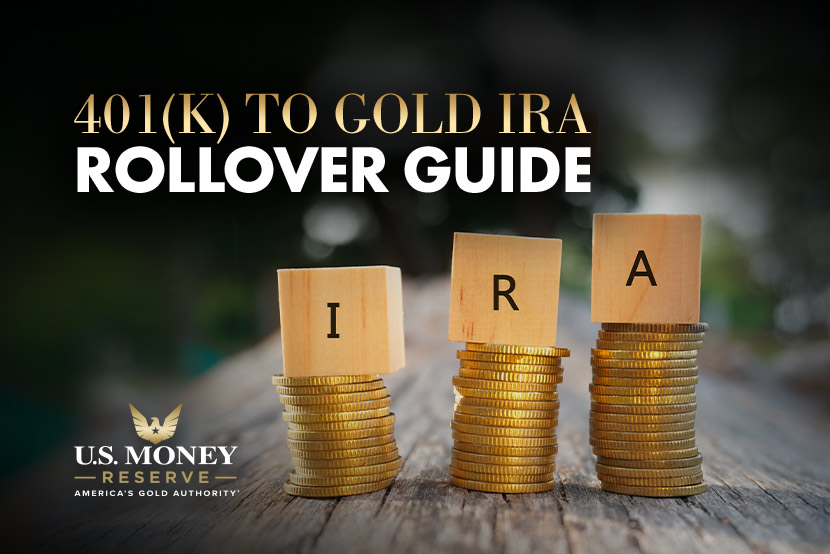To rollover a 401(k) to a Gold IRA, open a self-directed IRA account and initiate a transfer. Consult with your IRA custodian.
Rolling over a 401(k) to a Gold IRA offers a way to diversify your retirement portfolio. Gold IRAs allow you to invest in physical gold, which can provide stability during economic downturns. Many investors consider gold a hedge against inflation and market volatility.
The process involves opening a self-directed IRA account with a custodian who specializes in precious metals. Once the account is set up, you can initiate the transfer of funds from your 401(k) to the new Gold IRA. This move can safeguard your retirement savings and provide peace of mind.

Understanding 401(k) And Gold Ira
Investing for retirement is crucial. Two popular options include the 401(K) and Gold IRA. Each has unique benefits and rules. Understanding these can help you make informed decisions. Let’s dive into the basics of each.
Basics Of 401(k)
A 401(K) is a retirement savings plan. Employers offer it to their employees. It allows you to save and invest part of your paycheck before taxes. The invested amount grows tax-deferred. Withdrawals are taxed.
- Employers often match contributions.
- Contribution limits are set by the IRS.
- Early withdrawals may incur penalties.
- Funds are typically invested in mutual funds or stocks.
Basics Of Gold Ira
A Gold IRA is a type of Individual Retirement Account. It allows you to invest in physical gold. This can include gold bars and coins. Gold IRAs provide a hedge against inflation and market volatility.
- Offers diversification from traditional investments.
- Requires a custodian to manage the account.
- Includes storage fees for the physical gold.
- Investments are tangible assets.

Assessing Eligibility
Before rolling over a 401(K) to a Gold IRA, assess your eligibility. This step ensures a smooth transition and compliance with IRS rules. Understanding the rules and the types of 401(K) plans is crucial.
Rules And Regulations
The IRS has strict rules for 401(K) rollovers. Knowing these rules helps avoid penalties.
- You must be 59 1/2 years old to roll over without penalty.
- Follow the 60-day rule to complete the rollover.
- Rollovers must be reported to the IRS.
Check if your 401(K) plan allows in-service rollovers. This can vary between employers. Always consult a financial advisor for specific rules.
Types Of 401(k) Plans
Different 401(K) plans have different rules. Understanding your plan type is essential.
| Type of 401(K) | Eligibility for Rollover |
|---|---|
| Traditional 401(K) | Eligible after leaving the employer or at 59 1/2 |
| Roth 401(K) | Eligible after leaving the employer or at 59 1/2 |
| Solo 401(K) | Eligible anytime, but consult the plan administrator |
Knowing your plan type helps determine the best rollover strategy. Each plan has unique features. Understand your options thoroughly.
Choosing A Gold Ira Custodian
Rolling over a 401(K) to a Gold IRA requires careful planning. The first step is choosing a Gold IRA custodian. This decision is crucial as the custodian will manage your investments.
Factors To Consider
Choosing the right custodian involves several factors. Here is a breakdown:
- Experience: Look for custodians with a strong track record.
- Fees: Compare fees for account setup, storage, and management.
- Reputation: Check reviews and ratings from other investors.
- Customer Service: Ensure they offer excellent support.
Evaluate these factors to find a reliable custodian. An experienced custodian will guide you through the rollover process efficiently.
Top Custodians
Here are some top Gold IRA custodians:
| Custodian | Experience | Fees | Reputation |
|---|---|---|---|
| Regal Assets | 10+ years | Low | High |
| Goldco | 15+ years | Moderate | High |
| Birch Gold Group | 15+ years | Moderate | High |
Each custodian listed has a good reputation. Their experience and fees vary, so choose according to your needs.
Initiating The Rollover Process
Rolling over your 401(K) to a Gold IRA can be a great financial strategy. The process may seem complex, but it’s straightforward with the right steps. Let’s dive into initiating the rollover process.
Contacting Your Current Provider
Start by contacting your current 401(K) provider. Ask for the specific steps to initiate the rollover. They might have different processes, so get detailed information.
Request any necessary forms or documents. You might need to fill these out to start the rollover. Keep these documents safe. They are important for the next steps.
Filling Out Necessary Forms
Fill out the necessary forms provided by your current provider. These forms are essential to move funds from your 401(K) to a Gold IRA.
The forms usually ask for personal details and account information. Double-check all details before submitting the forms. Accuracy is crucial to avoid delays.
| Form | Purpose |
|---|---|
| Rollover Request Form | Initiates the transfer process |
| Gold IRA Application | Opens your new Gold IRA account |
Submit the forms to your 401(K) provider. They will review and process your request. This can take a few days, so be patient.
Once the forms are approved, your funds will transfer to your Gold IRA. You’ll receive confirmation of the transfer. Keep this for your records.
Transferring Funds
Transferring funds from your 401(K) to a Gold IRA can seem complex. This process involves specific steps to ensure a smooth transition. Understanding the difference between direct and indirect rollovers is crucial. Avoiding penalties is also essential during this transfer.
Direct Rollover Vs. Indirect Rollover
Direct rollovers are the safest way to move your funds. The money transfers directly from your 401(K) to your Gold IRA. No taxes or penalties apply.
In an indirect rollover, you receive the funds first. You must deposit these funds into the new IRA within 60 days. Missing the deadline leads to taxes and penalties.
Avoiding Penalties
To avoid penalties, choose a direct rollover. This method is straightforward and secure. Your funds move directly, and no taxes are withheld.
If you opt for an indirect rollover, act quickly. Deposit the funds into your Gold IRA within 60 days. This step is crucial to avoid penalties and taxes.
Steps to Avoid Penalties:
- Choose a direct rollover if possible.
- If using an indirect rollover, act within 60 days.
- Consult a financial advisor for guidance.
| Rollover Type | Process | Penalties |
|---|---|---|
| Direct Rollover | Funds move directly to Gold IRA | No penalties |
| Indirect Rollover | You receive funds first | Penalties if not deposited in 60 days |

Selecting Gold Investments
When rolling over a 401(K) to a Gold IRA, one crucial step is selecting gold investments. The right gold investments can protect your retirement savings. Let’s explore the types of gold allowed and how to evaluate gold products.
Types Of Gold Allowed
Not all gold is suitable for a Gold IRA. The IRS has specific rules:
- Gold Bars: Must be at least 99.5% pure.
- Gold Coins: Only certain coins are permitted.
| Type | Requirement |
|---|---|
| Gold Bars | 99.5% purity |
| Gold Coins | Approved by IRS |
Evaluating Gold Products
Choosing the right gold products is essential. Consider these factors:
- Purity: Ensure the gold meets IRS standards.
- Authenticity: Verify the legitimacy of the product.
Certified dealers can help ensure quality. Check for credible sources before buying.
Storage also matters. Choose a secure, IRS-approved depository.
Lastly, monitor market trends. Stay informed about gold prices and market conditions.
Monitoring And Managing Your Gold Ira
Monitoring and managing your Gold IRA is crucial for success. Regular reviews and adjustments ensure your investment stays on track. This section will guide you through essential steps.
Regular Reviews
Regular reviews help keep your Gold IRA healthy. Check your account statements monthly. Look for any unusual activity or fees. Make sure your investments match your goals. Track the performance of your gold investments. Compare them against market trends. Use online tools to monitor gold prices.
- Check account statements monthly.
- Look for unusual activity or fees.
- Ensure investments match goals.
- Track gold investment performance.
- Compare against market trends.
- Use online tools to monitor prices.
Adjusting Your Portfolio
Adjusting your portfolio ensures it aligns with your needs. Rebalance your investments yearly. Add more gold if prices are low. Sell some gold if prices are high. Diversify by adding other metals like silver or platinum. Consult with a financial advisor for expert advice.
- Rebalance investments yearly.
- Add gold if prices are low.
- Sell gold if prices are high.
- Diversify with silver or platinum.
- Consult a financial advisor.
Here’s a simple table to understand adjustments:
| Scenario | Action |
|---|---|
| Low gold prices | Add more gold |
| High gold prices | Sell some gold |
| Need diversification | Add silver or platinum |
Tax Implications
Rolling over your 401(K) to a Gold IRA has tax implications. Understanding these implications helps you make informed decisions.
Understanding Tax Benefits
There are key tax benefits to rolling over your 401(K) to a Gold IRA. Here are some of the benefits:
- Tax-deferred growth: Your investments grow without immediate tax.
- Lower taxable income: Contributions reduce your taxable income.
Investing in a Gold IRA offers protection against inflation. It also diversifies your retirement portfolio.
Potential Tax Liabilities
Be aware of potential tax liabilities when rolling over your 401(K) to a Gold IRA:
- Early withdrawal penalties: Withdrawing funds before age 59½ incurs penalties.
- Mandatory distributions: At age 72, you must take required minimum distributions (RMDs).
These distributions are taxed as regular income. Plan carefully to minimize these liabilities.
If you roll over a traditional 401(K) to a Roth Gold IRA, you will pay taxes on the rollover amount. This is a one-time tax event.
Consider consulting a tax advisor to navigate these complexities. They can help you maximize benefits and minimize liabilities.
Frequently Asked Questions
How Do I Transfer My Ira To Gold Ira?
To transfer your IRA to a gold IRA, contact a custodian specializing in precious metals IRAs. Complete the transfer paperwork. Fund the account by transferring assets. Select your preferred gold products. The custodian will purchase and store the gold for you.
How Much Do I Need To Start A Gold Ira Account?
You typically need $5,000 to $10,000 to start a gold IRA account. Minimum investment amounts vary by provider.
Is There A Free Gold Ira Kit?
Yes, many companies offer free gold IRA kits. These kits provide valuable information on gold IRAs and investing.
Can I Contribute To A Gold Ira?
Yes, you can contribute to a gold IRA. It allows you to invest in physical gold and other precious metals. Consult a financial advisor for specific contribution limits and rules.
Conclusion
Rolling over a 401(K) to a Gold IRA can be a smart financial move. It provides diversification and potential protection against inflation. Always consult with a financial advisor to ensure the process aligns with your retirement goals. By understanding the steps, you can make informed decisions for a secure future.






Leave a Reply